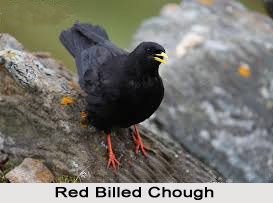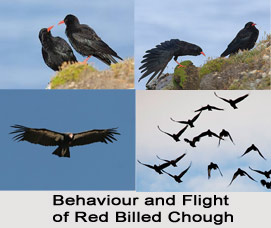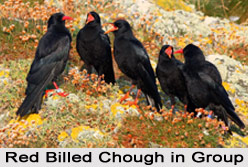 Red-Billed Chough is an Indian bird that bears a scientific name of "Pyrrhocorax pyrrhocorax" and belongs to the family of crow.
Red-Billed Chough is an Indian bird that bears a scientific name of "Pyrrhocorax pyrrhocorax" and belongs to the family of crow.
Breeding of Red-Billed Chough
The eight subspecies of Red-Billed Chough breed on mountains and coastal cliffs from the western coasts of Ireland and Britain east through southern Europe and North Africa to Central Asia, India and China.
Structure pf Red-Billed Chough
Red-Billed Chough has glossy black plumage, a long curved red bill, red legs, and a loud, ringing call. It has a buoyant acrobatic flight with widely spread primaries. The Red-Billed Chough pairs for life and displays fidelity to its breeding site, which is usually a cave or crevice in a cliff face. It builds a wool-lined stick nest and lays three eggs. It feeds, often in flocks, on short grazed grassland, taking mainly invertebrate prey.
Description of Red-Billed Chough
Red-Billed Chough was first described by Linnaeus in his Systema Naturae in 1758 as Upupa pyrrhocorax. It was moved to its current genus, Pyrrhocorax, by Marmaduke Tunstall in his 1771 Ornithologia Britannica.
Size of Red-Billed Chough
The size of the adult Red-Billed Chough is 39-40 centimetres (15-16 in) in length, has a 73-90 centimetres (29-35 in) wingspan, and weighs an average 310 gram (10.9 oz).
Plumage of Red-Billed Chough
The plumage of Red-Billed Chough is velvet-black, green-glossed on the body, and it has a long curved red bill and red legs. The sexes are similar (although adults can be sexed in the hand using a formula involving tarsus length and bill width) but the juvenile has an orange bill and pink legs until its first autumn, and less glossy plumage. 
Sounds of Red-Billed Chough
The sound of Red-Billed Chough is loud. The ringing chee-ow call is clearer and louder than the similar vocalisation of the jackdaw, and always very different from that of its yellow-billed congener, which has rippling preep and whistled sweeeooo calls. Small subspecies of the Red-Billed Chough have higher frequency calls than larger races, as predicted by the inverse relationship between body size and frequency.
Concentration of Red-Billed Chough
Red-Billed Chough concentrates in Ireland, western Great Britain, the Isle of Man, southern Europe and the Mediterranean basin, the Alps and in mountainous country across Central Asia, India and China, with two separate populations in the Ethiopian Highlands. It is a non-migratory resident throughout its range.
Habitat of Red-Billed Chough
The main habitat of Red-Billed Chough is high mountains; it is found between 2,000 and 2,500 metres (6,560-8,200 ft) in North Africa, and mainly between 2,400 and 3,000 metres (7,950-9,840 ft) in the Himalayas. In that mountain range it reaches 6,000 metres (19,650 ft) in the summer, and has been recorded at 7,950 metres (26,080 ft) altitude on Mount Everest. In Ireland, Great Britain and Brittany it also breeds on coastal sea cliffs, feeding on adjacent short grazed grassland or machair. It was formerly more widespread on coasts but has suffered from the loss of its specialised habitat. It tends to breed at a lower elevation than the Alpine chough, that species having a diet better adapted to high altitudes.
Egg of Red-Billed Chough
The egg size of Red-Billed Chough is independent of the clutch size and the nest site, but may vary between different females. The female incubates for 17-18 days before the altricial downy chicks are hatched, and is fed at the nest by the male. The female broods the newly hatched chicks for around ten days, and then both parents share feeding and nest sanitation duties. The chicks fledge 31-41 days after hatching.
 Feeding of Red-Billed Chough
Feeding of Red-Billed Chough
The food habit of Red-Billed Chough consists largely of insects, spiders and other invertebrates taken from the ground, with ants probably being the most significant item. The Central Asian subspecies P. P. centralis will perch on the backs of wild or domesticated mammals to feed on parasites. Although invertebrates make up most of the chough`s diet, it will eat vegetable matter including fallen grain, and in the Himalayas has been reported as damaging barley crops by breaking off the ripening heads to extract the corn. In the Himalayas, they form large flocks in winter. The preferred feeding habitat is short grass produced by grazing, for example by sheep and rabbits, the numbers of which are linked to the chough`s breeding success. Suitable feeding areas can also arise where plant growth is hindered by exposure to coastal salt spray or poor soils. It will use its long curved bill to pick ants, dung beetles and emerging flies off the surface, or to dig for grubs and other invertebrates. The typical excavation depth of 2-3 cm reflects the thin soils which it feeds on, and the depths at which many invertebrates occur, but it may dig to 10-20 cm in appropriate conditions.











